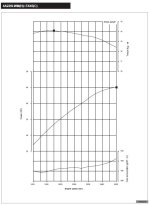Just an example.
If your pump can pump 10 GPM at 2500 psi, the pump needs about 17 HP.
If this pump is on a 25 HP tractor, it may not ever stall.
If you are stalling and the relief whines, that tells you that you are working at the relief pressure. .
If that pump is in a 17 HP tractor, then it may stall. Keep in mind you are also using some HP for traction, so you may run out of HP. Only way to fix that is more HP. You can adjust the pressure down so as not to stall, but you are also decrease hyd power.
I have three pumps on my Power-Trac, and each pump can go into relief if I am using all three pumps at the max.
Whenever you increase engine rpm's , you are pumping more GPM.
Pressure however is developed because of the resistance to the fluid in the cyl or hyd motors when used.
Relief valves are set to dump the over pressure until the load is removed.
A 3000 psi hyd gage installed inline at the IN port in a tee would be the best place to monitor and trouble shoot the hyd system.
The gage will tell you the operating pressure at any time as to the load on the hyd system and should tell you what is normal and when you are working at relief pressure.
All relief valves should be set the same, unless you want to set a particular relief valve to protect that hyd circuit.
With all valves in neutral, you may see no pressure or some back pressure because of restrictions in fittings, smaller hoses, valve slightly open, etc.
As far as hearing the whine or screeching from the relief valve you may not hear it all the time. That noise is caused by cavitation, and if the fluid does not cavitate, there is no sound.

